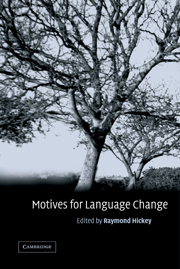Book contents
- Frontmatter
- Contents
- Notes on the contributors
- Acknowledgements
- Introduction
- Part I The phenomenon of language change
- Part II Linguistic models and language change
- 3 Metaphors, models and language change
- 4 Log(ist)ic and simplistic S-curves
- 5 Regular suppletion
- 6 On not explaining language change: Optimality Theory and the Great Vowel Shift
- Part III Grammaticalisation
- Part IV The social context for language change
- Part V Contact-based explanations
- Part VI The typological perspective
- Index
- References
4 - Log(ist)ic and simplistic S-curves
Published online by Cambridge University Press: 22 September 2009
- Frontmatter
- Contents
- Notes on the contributors
- Acknowledgements
- Introduction
- Part I The phenomenon of language change
- Part II Linguistic models and language change
- 3 Metaphors, models and language change
- 4 Log(ist)ic and simplistic S-curves
- 5 Regular suppletion
- 6 On not explaining language change: Optimality Theory and the Great Vowel Shift
- Part III Grammaticalisation
- Part IV The social context for language change
- Part V Contact-based explanations
- Part VI The typological perspective
- Index
- References
Summary
Introduction
The technical term S-curve goes back at least to 1839 (OED, as two words), and in the context of linguistic change certainly to 1954 (Altmann et al. 1983: 105). The importance of S-curves is now generally taken for granted in historical linguistics. Devitt, for example, asserts that ‘[t]he S-curve pattern of diffusion occurred throughout [her] data’ (1989: 75). Here is a more recent example concerning early Modern English morphosyntax (Nevalainen 2000: 339):
I need to be able to measure the degree of supralocalisation and subsequent standardisation of a linguistic variable. The measure I shall use will be the completion of an S-curve by the feature in question in the data examined.
In Nevalainen's paper, many graphs need just five or six data-points to reveal a jagged but nevertheless recognisably S-shaped form. I myself have long assumed ‘that the time course of the propagation of a language change typically follows an S-curve’, as Croft expresses it (2000: 183). In this chapter I wish to question why this might be so, what it means and why perhaps, in the end, it is actually rather unexpected. In touching on explanations of language change and notably the shape that changes take, there is a risk (or one might well say, the hope) of echoing some of Roger Lass's published work: there can be few topics in historical linguistics that he has not profitably addressed at some time or other.
Information
- Type
- Chapter
- Information
- Motives for Language Change , pp. 54 - 70Publisher: Cambridge University PressPrint publication year: 2003
References
Accessibility standard: Unknown
Why this information is here
This section outlines the accessibility features of this content - including support for screen readers, full keyboard navigation and high-contrast display options. This may not be relevant for you.Accessibility Information
- 51
- Cited by
